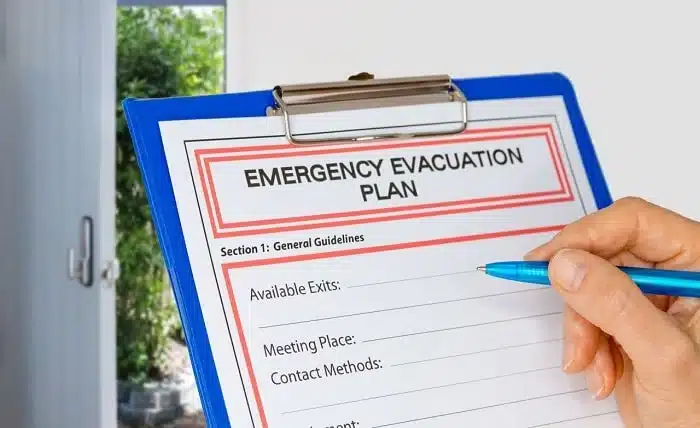Stay Prepared and Protect Your Loved Ones with a Family Emergency Plan

Having a family emergency plan is crucial. Emergencies, whether natural or man-made, can happen anytime, leaving families vulnerable and unprepared. This blog post provides essential steps to create a solid emergency preparedness plan for your family’s safety and peace of mind. We’ll guide you through understanding various emergencies and assembling effective emergency kits, while also addressing the special needs of children, seniors, and pets.
Essential Steps for Creating a Family Emergency Plan
Designating Meeting Spots and Communication Plans
Having a family emergency plan means knowing where to go and how to communicate during a crisis. Designate a safe meeting spot near your home and another one outside your neighborhood in case the situation requires relocation. Make sure everyone in the family knows the locations and how to get there.
Communication is paramount, especially when family members are separated. Create a plan that includes a list of emergency contacts, and decide on a method of communication, such as text messages or phone calls. It’s wise to have a family member or friend outside your immediate area serve as a point of contact.
Preparing Emergency Kits for Home and On-the-Go
An emergency kit is your lifeline during a crisis. For home preparedness, stock up on essentials like non-perishable foods, a first aid kit, and a water drum to ensure an adequate water supply. Don’t forget items such as flashlights, batteries, and a multi-tool. A well-prepared kit can help your family survive until help arrives.
For on-the-go emergencies, prepare a portable kit that includes similar essentials but in smaller quantities. Keep it accessible in your car or at your workplace. Having these items on hand can make a significant difference in your ability to react quickly and effectively.
Assigning Responsibilities and Understanding Emergency Alerts
Assign specific responsibilities to each family member, such as gathering supplies, securing the home, or comforting younger children. Ensuring everyone knows their role can help maintain order and efficiency during a chaotic situation.
Familiarize everyone with local emergency alerts by subscribing to community alert systems and downloading weather apps. Understanding the various alerts and their meanings will help you react appropriately and promptly.
Detailed Information on Different Types of Emergencies
Natural Disasters
Natural disasters can range from earthquakes to wildfires, each requiring specific preparations. Earthquakes demand sturdy furniture and clear evacuation routes, while flood readiness means knowing your area’s flood zones and having sandbags ready.
In hurricane-prone areas, secure windows and bring in outdoor furniture. Wildfire preparation includes clearing brush around your home and creating a defensible space. Being aware of the potential risks in your area is crucial for tailored emergency preparedness.
Man-Made Emergencies
Man-made emergencies such as home invasions, power outages, and chemical spills necessitate different precautions. Install security systems to protect against intruders and have a backup power source for outages, like a generator or solar-powered charger.
In chemical emergencies, knowledge of safe evacuation routes and shelter-in-place techniques is vital. Understanding the unique nature of each emergency type will allow you to tailor your plans and responses accordingly.
Guidance on Staying Informed and Updated during Emergencies
Utilizing Local News, Weather Apps, and Community Alert Systems
Staying informed is key to effective emergency preparedness. Regularly check local news channels and use weather apps to receive real-time updates. Community alert systems provide localized information and early warnings, helping you make informed decisions.
By keeping yourself updated, you can increase your family’s safety and be better prepared to take necessary action. Information is power, and in emergencies, it can be life-saving.
Understanding the Importance of Early Warnings and How to React to Them
Early warnings give you a head start in taking protective measures. Whether it’s a storm warning or an evacuation notice, knowing how to interpret and respond to these warnings is crucial.
Reacting calmly and swiftly to early warnings can dramatically reduce the impact of an emergency on your family. Practice scenarios with your family to ensure everyone knows what to do when a warning is issued.
Special Considerations for Families with Children, Seniors, and Pets
Tailoring Emergency Plans and Kits to Meet Specific Needs
Every family has unique needs, especially if you have children, seniors, or pets. Adjust your emergency kits to include children’s medications, senior health supplies, and pet necessities like food and a leash.
Tailor your family emergency plan to accommodate these specific needs, ensuring everyone in the family is cared for during an emergency. Specialized planning enhances your overall preparedness.
Tips for Helping Children and Seniors Cope with Emergencies
Children and seniors may require additional support during emergencies. For children, maintaining a sense of normalcy and providing emotional reassurance is key. Keep favorite toys and comfort items available to help ease anxiety.
Seniors, especially those with mobility or health issues, need extra assistance. Ensure their medical supplies are easily accessible and plan for any mobility challenges they may face during an emergency.
The Role of Community and Neighbors in Emergency Preparedness
Building a Support Network within Your Community
Community connections can provide invaluable support during emergencies. Establish relationships with neighbors and local organizations, sharing emergency plans and resources.
A strong support network can offer assistance, share critical information, and foster a sense of unity. Working together enhances survival and recovery efforts, making your community more resilient.
Participating in Emergency Response Training and Drills
Participating in local emergency response training and drills can prepare you for real-life scenarios. These activities build confidence and equip you with practical skills to handle emergencies effectively.
Encouraging your family and neighbors to join these efforts will strengthen your community’s overall preparedness, creating a safer environment for everyone.
Conclusion
Proactive emergency preparedness is crucial for your family’s well-being. Create a tailored family emergency plan by assembling emergency kits, discussing plans together, and engaging with your community. Stay informed and utilize online resources to enhance your readiness, ensuring you can confidently face any emergency.





